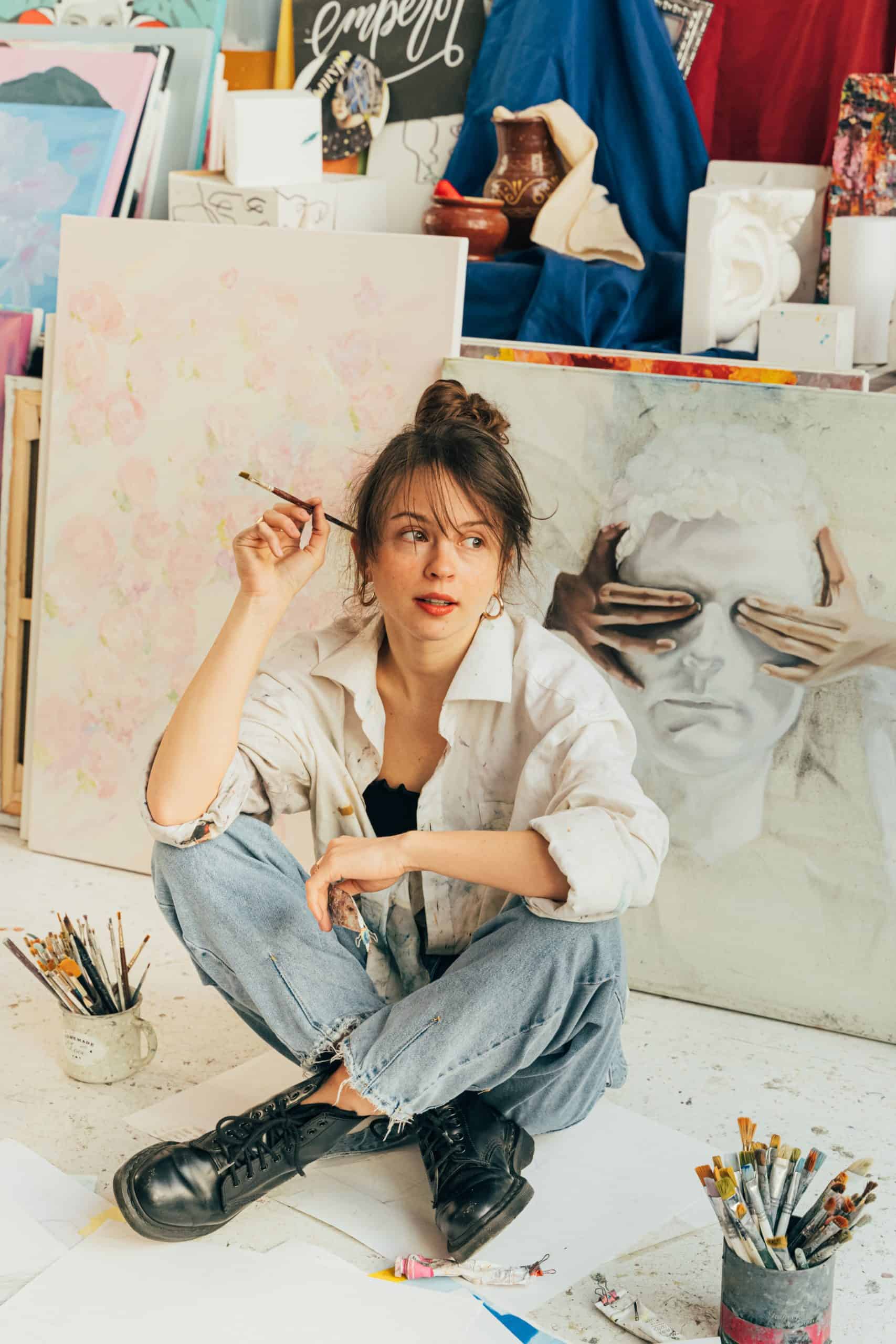
Tips for creating impressionist paintings
Creating an amazing impressionist painting needs a special combination of talent and imagination. With the right techniques and mindset, you can show subtle nuances and evoke emotions on the canvas. Here are some tips to help you create stunning impressionist paintings.
- To start, it is essential to understand the spirit of impressionism. This art movement began in the 19th century and aimed to portray moments in time, emphasizing the overall atmosphere rather than details. Use loose and quick brushstrokes to give a sense of movement and energy.
- Mastering color mixing is also important. Instead of using ready-made colors from a tube, try mixing different hues together to make colorful, harmonious combos. Play with warm and cool tones to give your artwork depth and dimension. The colors should blend when viewed from far away.
- Another great tip is to paint en plein air if you can. The natural light and outdoor environment give exceptional opportunities for an impressionist painter. Observe how light interacts with objects and landscapes in real time to show its fleeting qualities accurately.
- Also, pay attention to composition. Try asymmetry by putting your focal points off-center or using unusual angles. This will add visual appeal and energy to your artwork, guiding the viewer’s eye.
- Finally, don’t be afraid to be daring and expressive with your brushwork. Impressionism celebrates spontaneous marks on canvas, so take advantage of the freedom. Vary brush sizes, widths, angles, and pressure to get a range of textures and show light and shadow.
Understanding Impressionism
Impressionism, a revolutionary art movement of the 19th century, brought forth a new perspective. It challenged traditional artistic norms. Artists used vibrant colors, loose brushstrokes, and unconventional compositions to capture moments and light.
Impressionism allowed painters to move away from a formal approach. They focused on immediate visual impressions, instead of details. This shift evoked emotion and created an atmosphere. The paintings appeared spontaneous, yet carefully planned.
Unlike earlier styles, Impressionism celebrated the temporary. Everyday scenes inspired the artists: city streets, nature, water, and social gatherings. With a few brushstrokes, painters brought their subjects to life.
To use the techniques of the past, one must be experimental and spontaneous. Explore color palettes, use different brush sizes and textures, and avoid intricate details. Let intuition guide the brush and show your impressions on canvas.
Unlock the secrets of impressionism with dedication and practice. Grasp brushes, paints, and canvases. Go outside or explore urban scenes. Ignite creativity and let beauty thrive.
Take risks, accept imperfections, and capture moments. Express yourself and make impressions come alive on canvas. Start your journey today!
Materials Needed
Creating an impressive impressionist painting requires the right materials. Here are some essential items you’ll need:
- High-quality brushes with soft bristles and varying sizes.
- A palette knife for thick, textured brushstrokes.
- Artist-grade paints that are vibrant and long-lasting.
- A quality canvas or paper to paint on.
Additionally, to make your painting even more unique:
- Experiment with different techniques and blending methods.
- Try a limited color palette to set a specific mood.
- Vary the paint application with thin washes and thicker impasto.
Pro Tip: Let go of perfectionism and focus on conveying emotion. Spontaneity can be beautiful!
Preparing the Canvas
When it comes to crafting eye-catching impressionist paintings, prepping the canvas is a must! Here’s how:
- Choose a quality canvas that’s right for oil or acrylic.
- Use sandpaper to make any rough areas smooth.
- Put on a thin layer of gesso for a sweet, consistent surface.
- Let the gesso dry before getting to the painting.
- If you’re feeling fancy, add a layer of gesso for more texture.
- Give the canvas a final sanding to remove any imperfections.
Remember, preparing the canvas is step one in making your masterpiece! Here are a couple of extra tips:
- Take your time to make sure your canvas is in tip-top condition.
- Try using textured gels and multiple layers of gesso for added depth.
- Before beginning, make sure your workspace is orderly and clean.
Choosing a Subject
Choosing the best topic for an impressionist painting is a must! It’s vital for making a captivating and eye-catching art piece. Picking the right one can help you express the atmosphere and essence of the scene on canvas.
Here are some tips:
- Nature: Landscapes, gardens, or water bodies can be inspiring with their beauty and serenity.
- What about cityscapes? Busy places with lots of action or architectural marvels can be great subjects.
- Still life: Everyday items such as flowers, fruits, or household items can be turned into amazing compositions.
- Humans: Including figures in your paintings brings movement and storytelling.
- Light: Capturing light and shadow in different settings makes the painting even more captivating.
For more extra artistic effects, try focusing on fleeting moments or color harmonies. This will give more depth and interest to your masterpiece!
Pro Tip: Experiment with brushstrokes to get varied textures in different parts of the painting. This will bring energy and life to your artwork!
Sketching the Composition
- Sketching is a key part of impressionist painting. Start by lightly drawing the main shapes and forms.
- Don’t get lost in the details. Move angles and perspectives around for different looks.
- This lets you plan and visualize the painting before you start. It helps to guide viewers’ eyes through the artwork.
- Famous impressionist painters like Monet and Degas understood the importance of sketching. It helped them capture moments and impressions that were crucial for the impressionist style.
- By sketching out their paintings they could plan their brushstrokes and color choices to create masterful works of art.
Selecting Colors
When it comes to impressionism, colors are key! Vibrant hues and contrasting tones can bring your artwork to life. Go for bold shades like red, blue, and green to draw the viewer’s eye.
Claude Monet and Pierre-Auguste Renoir used complementary color schemes. These colors balance each other on the color wheel. This creates a captivating composition.
Impressionist painters also applied patches of paint side by side. This technique creates an optical illusion from far away, giving the artwork a luminous quality.
Interestingly, during the time period when impressionism emerged, traditional art circles did not accept bright and contrasting colors. Monet and Renoir challenged them by embracing vivid colors.
Let your palette burst with vibrant hues and create stunning pieces that leave a lasting impact. Embrace colors and capture moments with beauty and emotion!
Mixing Paints
Mixing paints is a must for impressionist paintings. It’s all about combining colors to get the right shades and tones. There are plenty of techniques to mix paints well.
- Start with a clean palette and different wells for each color.
- Blend them with a palette knife or brush.
- Mingle primary colors to make secondary ones.
- Add small amounts of paint to get the right intensity.
- Mix them softly without overdoing it to keep their brightness.
- Don’t forget to clean your brushes after each mixing.
To make your artwork stand out, try something different when mixing paints. Play around with different brush strokes and textures. This will add depth and life to your paintings.
Know this: The Metropolitan Museum of Art gurus say some impressionist painters, like Monet, mixed paints directly on the canvas instead of a palette. This gave them the chance to make spontaneous and vivid brushstrokes.
Applying the First Layers
To make a captivating impressionist painting, follow these 5 steps:
- Get a sturdy canvas and prime it. This gives you a nice surface to paint on.
- Pick a limited color palette that captures the subject matter. This makes the painting more coherent.
- Start with big brushes and broad strokes. Don’t worry about the details yet.
- Layer the paint gradually, waiting for each layer to dry before adding the next. This creates depth and texture.
- Experiment! Don’t be afraid to try new things. Let your creativity shine!
Details like blending colors and using different brush techniques are important too.
Reminder: Practice makes perfect. Don’t give up if your first attempts aren’t great. Keep experimenting and refining your skills.
Pro Tip: Take breaks to look at your work from a distance. This helps you make the right adjustments.
Blending and Creating Texture
Blending and texture are critical in impressionist art. Artists use tools like brushes, palette knives, and even fingers to make texture. They can build dimension by applying paint in various thicknesses and directions.
Blending is another important technique. This involves combining colors for smooth transitions. Brushstrokes are overlapped or a dry brush technique is used to soften edges.
Color temperature is a unique detail to consider when blending. By mixing warm and cool colors, artists can give depth and atmosphere to their paintings. For instance, warm tones blended into cool tones can look like sunlight filtering through foliage.
Experimenting with different brush sizes and shapes when creating texture is a great idea. Imitating natural textures, such as the bark of a tree or the petals of a flower, can bring a painting to life. Blend these textured brush strokes with other areas for the best effect.
Finally, light and shadow are essential for realistic textures. Applying highlights and shadows in the right places conveys the tactile qualities of objects.
Capturing Light and Shadows
Observe your subject first. Note where the light comes from and how it falls. Remember the illuminated and shadowed parts. This will help you grasp light and dark in your composition.
Choose your color palette next. Warmer tones for lit-up areas, cooler ones for shadows. This will give contrast and depth.
When you paint, think of brushstroke direction. Strong light needs bold strokes, shadows need softer ones.
Artists from centuries ago used light and shadows to give dimension. Rembrandt and Vermeer were masters at this. They still inspire us, to remember the importance of capturing light in our work.
Adding Details
Impressionist paintings captivate viewers with their unique colors and brushstrokes. To add details, use small dabs of paint for texture and depth. This engages viewers on a tactile level. Utilize broken brushstrokes to suggest details, giving the painting movement and spontaneity. Incorporate light and shadow to enhance the detailing. Observe the lighting conditions to strategically highlight certain areas. Also, consider composition. Position objects within the frame to guide the viewer’s gaze. Don’t be afraid to experiment and take risks. Embrace spontaneity and capture an essence or mood instead of accuracy.
Stepping Back and Assessing the Painting
Gain insights into your impressive impressionist paintings by stepping back and assessing your work. Here’s a simple guide:
- Take a break. Give yourself time away from the canvas to clear your mind and view it with fresh eyes.
- Create distance. Stand far enough away to see the whole piece without any obstructions.
- Analyze details. Look for areas where brushstrokes can be improved or elements that could be modified or removed.
- Trust your instincts. Artistic choices often come from personal expression, so trust your gut.
Remember that no two artists are the same, so don’t compare yourself harshly. Use this method to improve and achieve stunning results! Step back and assess today!
Making Adjustments
Adjusting is an integral part of creating incredible impressionist paintings. Follow these 6 simple steps to get the desired effect:
- Look at your painting and identify which areas need adjusting.
- Use a soft brush or sponge to blend colors for a perfect transition.
- Try different brushstrokes to add texture and depth.
- Change the composition by adding or removing elements for correct balance.
- Pay attention to light and shadow, adjusting to make it look real.
- Step back often to check progress and make changes.
Moreover, think of unique details when making adjustments in impressionist paintings. Concentrate on conveying the subject’s essence rather than copying each detail. Utilize strong, deliberate strokes to express feelings and atmosphere.
A fascinating story related to this topic is about Claude Monet. During his time in Giverny, Monet created many masterpieces. He would keep adjusting his paintings, even after they were deemed complete. This dedication to excellence shows the importance of continuous improvement in producing captivating impressionist art.
Remember, when it comes to adjusting to impressionist paintings, stay patient and open-minded. Be brave to experiment and let your creativity lead you to marvelous results.
Final Touches and Finishing the Painting
Impressionist paintings come alive with a few unique touches. Here’s a 5-step guide to add that extra charm:
- Highlight details: Focus on the small details of your painting – use smaller brushstrokes or fine lines to highlight them.
- Create shadows: Use darker shades to create shadows and give your artwork dimension. Focus on where light would naturally cast shadows.
- Contrast colors: Experiment with complementary colors to make elements stand out. For example, use warm tones against cool backgrounds.
- Incorporate textures: Vary brushstrokes or add the impasto technique to add depth and make the artwork visually interesting.
- Finish with varnish or glaze: Apply a protective coat of varnish or glaze to enhance colors and protect from dust and aging.
In impressionist art, movement is key. Use brushstrokes that suggest motion and energy to give life to your subjects.
Let your creativity take over as you finish your masterpiece! Did you know Claude Monet once said, “I’m following nature without grasping her…I perhaps owe becoming a painter to flowers”?
Conclusion
A masterpiece can be born when paint and strokes come together in harmony. Impressionist paintings can capture a moment’s essence with vivid colors and loose brushwork. You can create your own stunning impressionist artwork by following specific techniques.
Start by selecting a subject that excites you. It could be a portrait, a landscape, or an everyday scene. Focus on the atmosphere and mood, not realism. Play with different color palettes and brush sizes.
Then, use the power of light and its ever-shifting nature. Impressionists typically painted in natural settings. Try painting outdoors or near a window to observe how light changes your subject. Choose bold colors to represent the interaction between light and shadows.
The brushwork is also key for an impressionist painting. Don’t use small, precise strokes that create a smooth finish. Instead, use broader brush strokes for movement and texture. Leave some underlying paint layers visible in certain areas to provide depth and dimension.
Also, don’t be afraid to experiment with other painting tools besides brushes. Palette knives, sponges, and even fingers can add interesting textures and patterns. Unleash your creativity to discover new ways of applying paint to the canvas.
Frequently Asked Questions
FAQs – Tips for creating impressionist paintings
1. What is impressionism?
Impressionism is an art movement that emerged in the late 19th century. It focuses on capturing the essence of a subject through short brushstrokes and vibrant colors, emphasizing the play of light and its ever-changing effects.
2. How can I choose the right subject for an impressionist painting?
When selecting a subject, look for scenes or objects that have dynamic light conditions or interesting color variations. Natural landscapes, cityscapes, and outdoor scenes during different times of the day can be excellent choices for impressionist paintings.
3. What kind of brushwork should I use for impressionist paintings?
Impressionist paintings often feature loose and spontaneous brushwork. Use a variety of brush sizes and shapes to create different effects. Experiment with short, broken, or dappled brushstrokes to convey movement and texture.
4. How can I achieve vibrant and harmonious colors in my impressionist paintings?
To achieve vibrant colors, use a limited palette with a wide range of hues. Mix colors directly on the canvas rather than on the palette to create interesting color variations. Be bold in your color choices and focus on capturing the overall mood and atmosphere of the scene.
5. Should I rely on photographs for reference in impressionist painting?
While photographs can be useful references, it is important to sketch and observe your subject directly whenever possible. This allows you to capture the fleeting qualities of light and atmosphere that photographs may not accurately convey.
6. What are some famous impressionist painters I can study for inspiration?
Some famous impressionist painters whose works you can study for inspiration include Claude Monet, Pierre-Auguste Renoir, Edgar Degas, and Camille Pissarro. Analyze their techniques, brushwork, and color choices to gain insights into the impressionist style.
Subject: Tips for creating impressionist paintings
Company: Hollywood Connections Center
Network: MyHollywoodPage.com
The Hollywood network of arts and creative professionals.





